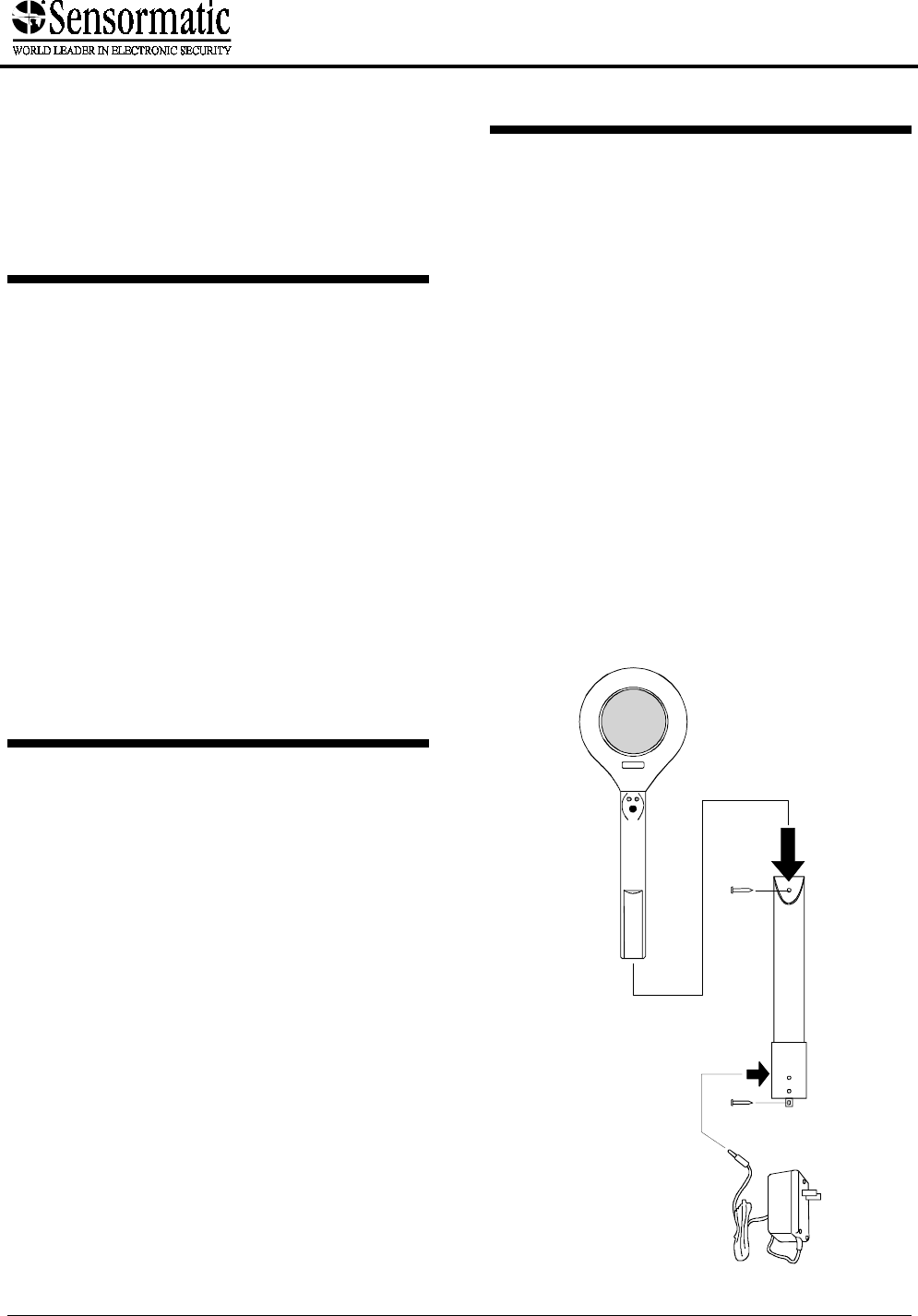Tyco Safety Sensormatic UMPHSR-R User Manual Users Instructions
Tyco Safety Products/Sensormatic Users Instructions
Contents
- 1. Users Instructions
- 2. resubmit Users Guide
Users Instructions

User’s Guide
8000-2668-01, Rev. A (2 pages) ULTRA•MAX EAS PRODUCTS 1
1
11
1 Ultra•Max
Ultra•MaxUltra•Max
Ultra•Max
Hand-Held Verifier
Hand-Held VerifierHand-Held Verifier
Hand-Held Verifier
About the Unit
About the UnitAbout the Unit
About the Unit
The Ultra•Max hand-held verifier is a battery-
operated, rechargeable, device used to:
• detect active Ultra•Max labels or tags at store
exits so they can be returned to the checkout
counter for proper deactivation or removal.
• audit incoming merchandise for source tagging
compliance.
The verifier works by generating a short-range
field and then listening for signal from an active
Ultra•Max label or tag. If a signal is detected, the
verifier alarms. The verifier consists of a:
• Wand
• Wall-mounted charger
• Power supply
Installing the Charger
Installing the ChargerInstalling the Charger
Installing the Charger
IMPORTANT! To ensure installation complies with
all applicable codes and regulations, install the
charger exactly as follows:
1. Using two screws provided, mount charger
vertically to any flat surface with its open end
facing up (see diagram).
2. Plug cord of power supply into side of charger.
3. Plug power supply into an AC wall outlet.
Green light on charger should light.
Charging the Wand
Charging the WandCharging the Wand
Charging the Wand
1. With the lights on the wand facing you, slide
handle of wand into tube of charger and push
down.
a. Top light on charger turns red to indicate
charging, which can take up to 10 hours
max. When top light turns green, wand is
fully charged. Wand should be fully charged
before using it for the first time.
b. This product uses a nickel cadmium battery.
To maximize battery life, fully discharge
battery before recharging.
c. Power supply may get slightly warm during
charging (this is normal).
2. Remove wand from charger. Charge should
last for about 5 hours.
WARNING: Place wand in charger only for
recharging, not for routine storage. If you want to
use charger for storage, then unplug power supply
when not recharging.
Wand
Charger
Power Supply

2 USER’S GUIDE ULTRA•MAX EAS PRODUCT
S
8000-2668-01, REV.
A
Using the Wand
Using the WandUsing the Wand
Using the Wand
You detect active labels and tags as follows:
1. Hold button on wand down.
2. The wand will go through an initialization
routine (see below).
3. Continuing to hold the button down, move
wand in a circular motion over item. If the red
light on the wand glows and a steady beep
occurs (with the green light remaining lit), then
an active label or tag has been found.
Initialization Routine
Initialization RoutineInitialization Routine
Initialization Routine
The wand has a button, a buzzer, and two lights
(red and green). When you first press down the
button, the lights and buzzer go through a
sequence as follows:
a. Red flashes once
b. Green flashes once
c. Short beep occurs
d. Green light glows steadily and remains on.
The verifier is then ready to detect labels or tags.
Note: Large metal surfaces can affect detection.
The red light on the wand will blink when metal is
detected; in which case, move the wand at least
1m (3') away from the metal and retry. If the green
light blinks, then wand needs to be recharged.
Specifications
SpecificationsSpecifications
Specifications
AC power (N. America) .......120Vac, 1A (60Hz) Class 2
AC power (Europe) .............230Vac, 0.5A (50Hz) LPS
Detection height ..................5cm to 10cm (2" to 4")
Battery operating time.........5 hours
Battery recharge time..........10 hours max.
Weight of wand ...................640g (22.6 oz)
Weight of charger................240g (8.5 oz)
Declarations
DeclarationsDeclarations
Declarations
Regulatory Compliance
Regulatory ComplianceRegulatory Compliance
Regulatory Compliance
EMC(wand & charger)........47 CFR, Part 15
I-ETS 300330
ETS 300683
Safety (power supply) ........Certified Class 2
EN60950 LPS
Safety (wand & charger) ....EN60950
FCC COMPLIANCE: This equipment complies with Part
15 of the FCC rules for intentional radiators and Class A
digital devices when installed and used in accordance with the
instruction manual. Following these rules provides reasonable
protection against harmful interference from equipment
operated in a commercial area. This equipment should not be
installed in a residential area as it can radiate radio frequency
energy that could interfere with radio communications, a
situation the user would have to fix at their own expense.
EQUIPMENT MODIFICATION CAUTION: Equipment
changes or modifications not expressly approved by
Sensormatic Electronics Corporation, the party responsible for
FCC compliance, could void the user's authority to operate the
equipment and could create a hazardous condition.
Other Declarations
Other DeclarationsOther Declarations
Other Declarations
WARRANTY DISCLAIMER: Sensormatic Electronics
Corporation makes no representation or warranty with respect
to the contents hereof and specifically disclaims any implied
warranties of merchantability or fitness for any particular
purpose. Further, Sensormatic Electronics Corporation
reserves the right to revise this publication and make changes
from time to time in the content hereof without obligation of
Sensormatic Electronics Corporation to notify any person of
such revision or changes.
LIMITED RIGHTS NOTICE: For units of the Department
of Defense, all documentation and manuals were developed at
private expense and no part of it was developed using
Government Funds. The restrictions governing the use and
disclosure of technical data marked with this legend are set
forth in the definition of "limited rights" in paragraph (a) (15)
of the clause of DFARS 252.227.7013. Unpublished - rights
reserved under the Copyright Laws of the United States.